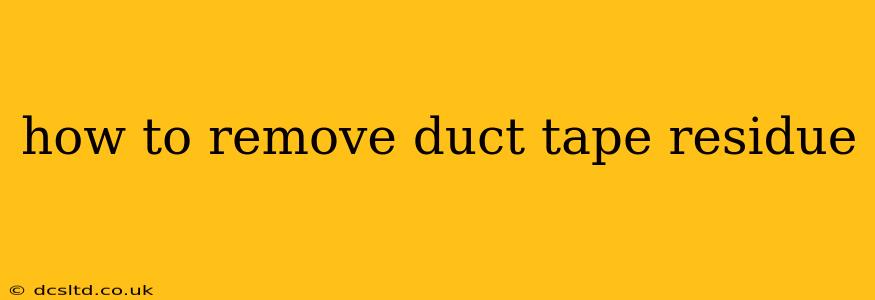Duct tape is incredibly versatile, but its stickiness can leave behind a frustrating residue after removal. This residue can be stubborn, clinging to various surfaces like wood, metal, glass, and plastic. Luckily, there are several effective methods to tackle this common problem, ranging from simple household items to specialized cleaning products. This guide will walk you through various techniques, helping you choose the best approach depending on the surface and the severity of the residue.
What Causes Duct Tape Residue?
Before diving into removal methods, understanding the culprit helps. Duct tape's adhesive is a powerful blend of polymers designed for strong adhesion. When you peel off the tape, some of this adhesive remains behind, creating that sticky mess. The type of surface also plays a role; porous surfaces like wood tend to absorb more adhesive than non-porous ones like glass.
Common Methods for Removing Duct Tape Residue
Here are some effective methods, categorized for clarity:
1. Using Heat:
This is often the first approach to try. Heat softens the adhesive, making it easier to remove.
-
Hair Dryer: Gently heat the residue with a hairdryer held a few inches away. Avoid overheating the surface. Once the adhesive softens, use a plastic scraper or a credit card to carefully lift it away. Wipe clean with a damp cloth.
-
Heat Gun (Caution!): A heat gun provides more intense heat, but requires extreme caution. Hold the gun several inches away and move it constantly to prevent damaging the surface. This method is best for stubborn residue on robust surfaces. Always test a small, inconspicuous area first.
2. Using Solvents:
Several solvents can effectively dissolve duct tape adhesive. Always test a small, inconspicuous area first to ensure it doesn't damage the surface.
-
Isopropyl Alcohol (Rubbing Alcohol): Apply rubbing alcohol to a clean cloth and gently rub the residue. For tougher spots, let the alcohol sit for a few minutes before wiping.
-
White Vinegar: Similar to rubbing alcohol, apply white vinegar to a cloth and rub gently. This is a gentler option suitable for delicate surfaces.
-
WD-40: WD-40 is a versatile lubricant and degreaser that can effectively dissolve the adhesive. Spray it lightly onto the residue, let it sit for a few minutes, then wipe clean. Ensure adequate ventilation when using WD-40.
-
Goo Gone: This commercially available product is specifically designed for removing sticky residue. Follow the instructions on the product label.
3. Using Abrasives (Use with Caution):
For very stubborn residue, you might need a slightly more abrasive approach. Proceed with extreme caution to avoid scratching the surface.
-
Baking Soda Paste: Make a paste of baking soda and water. Apply it to the residue and let it sit for a few minutes before gently scrubbing with a soft cloth or sponge.
-
Magic Eraser (Melamine Sponge): Dampen a Magic Eraser and gently rub the residue. This method can be effective but can also be abrasive, so use it cautiously, especially on delicate surfaces.
4. Using Adhesive Removers:
Specialized adhesive removers are available at most hardware stores. These products are formulated to dissolve various types of adhesive, including duct tape residue. Always follow the manufacturer's instructions.
Which Method is Best for Different Surfaces?
The best method depends largely on the surface:
- Glass: Isopropyl alcohol or white vinegar are generally safe and effective.
- Wood: Test a small, inconspicuous area before using any solvent. White vinegar is a gentler option.
- Metal: Isopropyl alcohol, WD-40, or a specialized adhesive remover can be effective.
- Plastic: Test a small area first. Isopropyl alcohol is a good starting point.
- Painted Surfaces: Use caution with solvents. Test a small area before applying to the entire surface.
Frequently Asked Questions (FAQ)
How do I remove duct tape residue from carpet?
Removing duct tape residue from carpet requires a gentler approach. Try gently scraping away loose residue with a dull knife or spatula. For stubborn spots, use a carpet cleaner or a specialized adhesive remover, being sure to test a small inconspicuous area first.
What’s the best way to remove duct tape residue from painted walls?
For painted walls, use a gentle approach. Start with a soft cloth and rubbing alcohol or white vinegar. Test a small area first to ensure the paint isn't affected. Abrasive methods should be avoided.
Can I use nail polish remover to remove duct tape residue?
While nail polish remover (acetone) can dissolve some adhesives, it can also damage certain surfaces. It's generally not recommended unless you've tested it on a hidden area and are certain it won't harm the surface.
How can I prevent duct tape residue in the first place?
To minimize residue, use a low-tack tape or apply the tape carefully to avoid stretching or excessive pressure. When removing the tape, pull it slowly and at a low angle to prevent tearing and leaving behind adhesive.
By following these methods and understanding the different surfaces you are working with, you can effectively remove duct tape residue and restore your surfaces to their original condition. Remember to always test any cleaning solution on a small, inconspicuous area before applying it to the entire affected area.
